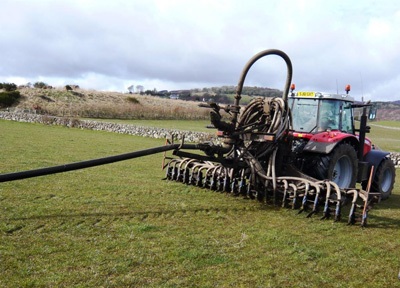Slurry spreading guidelines for NVZ
30 October 2017The welcome decision by Scottish Government to assess individual farmers needs to allow the spreading of slurry within the closed period, will come as a welcome relief to many farmers within Scotland’s NVZ areas.
You can find the full press release here.
In South West Scotland in particular, it is estimated that around 1000 acres of silage is still to be harvested in the Stranraer Lowlands NVZ alone, and for those who did get crops off in late August and early September, the continual wet weather has meant that slurry, which would normally be spread on aftermaths is still sitting in stores. This is not a blanket derogation and farmers MUST apply to their local SGRPID office who “will look sympathetically, with as much flexibility as the regulations allow, at the scope for any mitigation of the risk of penalties being applied.” Should approval be given, farmers should bear the following in mind when spreading slurry and take any possible steps to increase storage;
- Wherever possible, non -NVZ land should be used
- Don’t try and empty your whole tank. The purpose of the slurry application should be to empty the stores to allow you to meet the requirements of the remainder of the closed period relevant to your farm
- Applications should only be made to land that is regarded as low risk. Choose the driest fields for spreading, (even if these aren’t the ones closest to the steading); select fields that are flat or less than 5% slope and not known to be usually waterlogged at this time of the year; choose fields that have no watercourses or ditches as boundaries
- Reduce application rates to around 1000 gallons/acre per application to reduce the risk of run-off
- Don’t spread the same ground within 3 weeks of a previous application
- Where possible use an umbilical system for spreading rather than tankers to reduce field damage
- Any suitable field which has a water course as its boundary should not have slurry applied within 30m of this watercourse. In this instance slurry applications should be restricted to the centre and area of the field furthest away from the watercourse
- Don’t spread within 30m of a watercourse or 50m of a well
- If spreading on gently sloping land (less than 5%), try and enter the field at the top of the slope to reduce damage from hauling uphill – opening a fence to create a temporary entrance in a fence could make a huge difference
- Keep public roads clear of mud if you use them to access fields
- Take steps to divert as much clean water from entering slurry stores as possible – repair broken gutters, use temporary bunds to divert water from clean concrete
- Do everything you can to minimise pollution, bearing in mind that penalties could still apply if a pollution incident occurs
- All applications should be recorded in NVZ records.
Sign up to the FAS newsletter
Receive updates on news, events and publications from Scotland’s Farm Advisory Service

